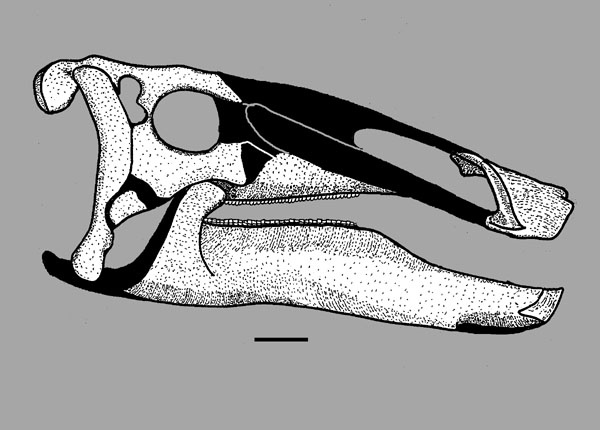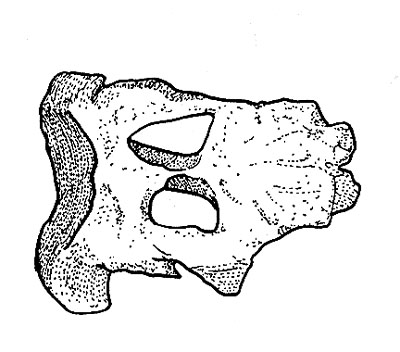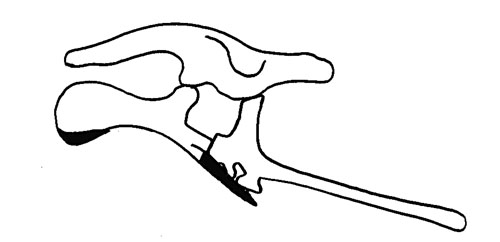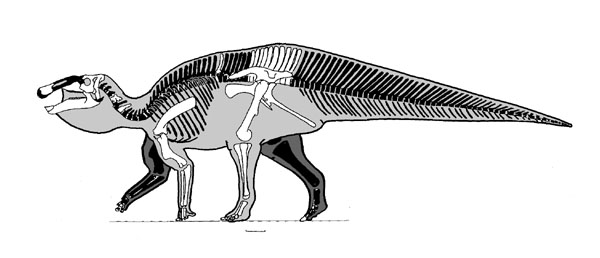Numbers: Not given.
Posterior cervical, anterior dorsal vertebrae, metacarpal left III, right metacarpal IV, right ischium, left radius, last dorsal vertebrae, mid-dorsal vertebrae, left ulna, right pes, left scapula, right scapula, right pubes, left sternal bone, left humerus, right humerus, right pubis, left sternal bones, left and right ilium, right tibia, left tibia, left fibula, left pubis.
No. 1: Left humerus, left femur.
No. 2: Left humerus, left femur.
No. 3: Left femur, right humerus.
No. 4: Right femur, right humerus.
No. 5: Right humerus, right femur.
No. 6: Right humerus.
HONE, WANG, SULLIVAN, ZHAO, CHEN, LI, JI, JI, & XU, 2011
Locality: Zangjiazhuang, Zhucheng City, Shandong Province, China.
Horizon: Wangshi Formation.
Biostratigraphy:
Age: ?Campanian Stage, Senonian Subepoch, Gulf Epoch, Late Cretaceous.
Material:
Numbers: Not given:
XING, ZHAO, WANG, LI, CHEN, MALLON, ZHANG, & XU, 2014
Localities: ZCDM KB, Kugou Locality; ZCDM LB, Longgujian locality; SCDM ZB1, Zangjiazhuang locality; ZCDM ZB2, Zangjiazhuang locality, Zhucheng City, Shandong Province, China.
Horizon: Wangshi Formation.
Biostratigraphy:
Age: ?Campanian Stage, Senonian Subepoch, Gulf Epoch, Late Cretaceous.
Material:
ZCDM HS0003: Partial articulated posterior part of one skull, including the nearly complete skull roof and the dorsal half of the neurocranium.
ZCDM HS0004: Partial, articulated posterior portion of the skull, including the nearly complete skull roof and the neurocranium missing the basicranial region.
ZCDM HS0008: Left nasal lacking the anterior two-thirds of the anterodorsal process.
ZCDM HS0023: Left dentary with a partial dental battery.
ZCDM HP0036: Left pubis.
= Shandongosaurus cf. giganetus XUE, ZHANG, BI, YUE & CHEN, 1995 (sic)
Locality: Intermontane Basin, Eastern part of Qinling, China.
Horizon:
Biostratigraphy:
Age: Late Cretaceous.
Material:
NWUV1114.1: Humerus.
NWUV1114.2: Femur.
NWUV1114.3: Tibia?
NWUV1114.4: Fragment of fibula?
NWUV1114.5: Distal end of a tibia?
NWUV1114.6: Phalange.
NWUV1114.7: Phalange.
NWUV1114.9: Coracoid?
NWUV1114.10: ?
NWUV1114.11: ?
NWUV1114.12: Tooth.
NWUV1114.13: Fragment of tooth.




XU, WANG, ZHAO, SULLIVAN & CHEN, 2010
Locality: Kugou, Zhucheng County, Shandong Province, China.
Horizon: Wangshi Group.
Biostratigraphy:
Age: Late Cretaceous.
Material:
Numbers: Not given: Bonebed.
= Zhuchengosaurus maximus ZHAO, LI, HAN, ZHAO, LIU, LI & FANG, 2007
Etymology:
Latin, maximus, "greatest."
Holotype: ZCDM HS0001
Locality: Zhucheng, Shandong Province, China.
Horizon: Wangshi Formation.
Biostratigraphy:
Age: Late Cretaceous.
Material: ZCDM HS0001: Incomplete articulated posterior part of one skull, including most of the braincase, as well as the paired postorbitals and squamosals and partial skeleton.
Referred material:
ZCDM HP0227: Humerus.
ZCDM HP0021: Scapula.
ZCDM HP0120: Femur.
ZCDM HP0218: Tibia.
SCDM HP0100: Ilium.
= Huaxiaosaurus aigahtens ZHAO, WANG & LI,
2011
Etymology: aigahtens is unusual in that it isn't a real word. Apparently, it's supposed to mean gigantic or enormous, with the Chinese "jù dà" and the Latin "giganteus" meaning exactly the same thing and if you take aigahtens and replace the first "a" with "g", the "h" with "n" and the last "n" with "u" you get... giganteus (from http://www.dinochecker.com/dinosaurs/HUAXIAOSAURUS
).
Holotype: SCDM HS0002
Locality: Zhucheng, Shandong Province, China.
Horizon: Wangshi Formation.
Biostratigraphy:
Age: Late Cretaceous.
Material: Fragmentary skull.
Referred material:
ZCDM HP0073: Humerus.
ZCDM HP0133: Scapula.
ZCDM HP0250: Femur.
ZCDM HP0391: Tibia.
ZCDM HP0173: Ilium.